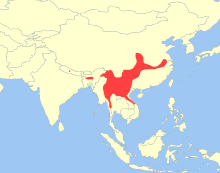Great evening bat
| Great evening bat | |
|---|---|
| Scientific classification | |
| Domain: | Eukaryota |
| Kingdom: | Animalia |
| Phylum: | Chordata |
| Class: | Mammalia |
| Order: | Chiroptera |
| Family: | Vespertilionidae |
| Genus: | Ia |
| Species: | I. io
|
| Binomial name | |
| Ia io | |
| Subspecies | |
| |

| |
| Geographic range | |
| Synonyms[4][5] | |
| |
The great evening bat (Ia io) is the largest bat in the vesper bat family (Vespertilionidae) and the only living species in the genus Ia. It is common to Eastern and Southeastern Asia (China, India, Laos, Nepal, Thailand and Vietnam),[1] mainly living in areas with limestone caves at altitudes of 400–1,700 metres (0.25–1.06 mi).[6] Their roost sites have been found both near the cave entrances and up to 1.5 kilometres (0.93 mi) within the cave systems.[7]
Description
[edit]The great evening bat reaches a length of 90 to 105 millimetres (3.5–4.1 in). It is colored brown on the top and grayish on the bottom.[8] Average wingspan is 51 cm (20 in) and it typically weighs 58 g (2.0 oz).[9]
Not much is known about its habits and behavior. The bat usually lives in small groups. Its food consists of insects, as with most vesper bats. The great evening bat also sometimes feeds on small birds.[9] The bat leaves its sleeping place in the late afternoon to search of food. During the winter months it may migrate to warmer regions.
Status
[edit]The IUCN lists its conservation status as near-threatened.[1] One of the threats to its survival in South Asia is human influence by habitat destruction; many caves have been turned into attractions. They have also been disturbed by farmers collecting their excrement. Also the excessive use of insecticides poses a threat to the great evening bats.[6]
Scientific name
[edit]At four letters, Ia io is tied with Yi qi for the shortest existing (and shortest possible) scientific name of any animal under the International Code of Zoological Nomenclature,[10] and is one of very few scientific names composed solely of vowels.[11]
The name has traditionally been associated with Io, a figure in classical mythology who was viewed as "flighty," and ia (ἰά), a Greek word signifying a shout or cry.[12][13][14][15]
However, recent interpretations by Griffiths (2022) suggest an alternative meaning behind Oldfield Thomas's choice of name. Instead of a reference to mythology, the name Ia io might be a joyful exclamation, translating to 'Shout hurrah!'. This interpretation posits that Thomas, who had recently become a Fellow of the Royal Society, was expressing his elation through the naming of this species. This explanation adds a new layer to the understanding of the species name, considering Thomas's scholarly background and the timing of the bat's discovery.[16]
See also
[edit]References
[edit]- ^ a b c Jiang, T.L.; Feng, J. (2020). "Ia io". IUCN Red List of Threatened Species. 2020: e.T10755A21993508. doi:10.2305/IUCN.UK.2020-2.RLTS.T10755A21993508.en. Retrieved 19 November 2021.
- ^ Thomas, Oldfield (1902). "On Two new Mammals from China". Annals and Magazine of Natural History. 7. 10 (56): 164–166. doi:10.1080/00222930208678653.
- ^ Soisook, Pipat; Sribuarod, Kriangsak; Karapan, Sunate; Safoowong, Mongkol; Billasoy, Sawwalak; Thong, Vu Dinh; Chang, Yang; Gong, Lixin; Lin, Aiqing; Sztencel-Jabłonka, Anna; Bogdanowicz, Wiesław; Bates, Paul J. J. (2017). "The first record of Ia io Thomas, 1902 (Mammalia: Chiroptera: Vespertilionidae) from the Sundaic Subregion, with a description of a new subspecies from peninsular Thailand". Zootaxa. 4344 (3): 573–588. doi:10.11646/zootaxa.4344.3.8. PMID 29245626.
- ^ Topál, Gy. (1970). "The First Record of Ia io Thomas, 1902 in Vietnam and India, and Some Remarks on the Taxonomic Position of Parascotomanes beaulieui Bourret, 1942, Ia longimana Pen, 1962, and the Genus Ia Thomas, 1902 (Chiroptera: Verspertilionidae)" (PDF). Opuscula Zoologica (Budapest). 10 (2): 341–347.
- ^ Csorba, Gábor (1998). "The Distribution of the Great Evening Bat Ia io in the Inodmalayan Region" (PDF). Myotis. 36: 197–201.
- ^ a b "Great Evening Bat". China Species Information Service (CSIS). Institute of Zoology, Chinese Academy of Sciences. Archived from the original on 2006-05-15. Retrieved 2006-05-10.
- ^ C.M. Francis; A. Guillén; M.F. Robinson. "Wildlife of Lao PDR: 1999 status report – Order Chiroptera" (PDF). Wildlife Conservation Society. Archived from the original (PDF) on 2006-01-07. Retrieved 2006-05-10.
- ^ Nowak, Ronald M. (1999). Walker's Mammals of the World. Johns Hopkins University Press. ISBN 0-8018-5789-9.
- ^ a b Thabah, Adora; Li, Gang; Wang, Yinan; Liang, Bing; Hu, Kailiang; Zhang, Shuyi; Jones, Gareth (2007). "Diet, Echolocation Calls, and Phylogenetic Affinities of the Great Evening Bat (Ia io; Vespertilionidae): Another Carnivorous Bat". Journal of Mammalogy. 88 (3): 728–735. doi:10.1644/06-MAMM-A-167R1.1.
- ^ "International Code of Zoological Nomenclature, Chapter 4, Article 11.8". code.iczn.org. Retrieved 29 May 2020.
- ^ Yanega, Doug. "Curious Scientific Names". Archived from the original on 20 June 2019. Retrieved 11 August 2019.
- ^ Srinivasulu, Chelmala (September 3, 2018). South Asian Mammals: An updated Checklist and Their Scientific Names. CRC Press. ISBN 9780429880896 – via Google Books.
- ^ Beolens, Bo; Watkins, Michael; Grayson, Michael (November 18, 2009). The Eponym Dictionary of Mammals. JHU Press. ISBN 9780801895333 – via Google Books.
- ^ Liddell, Henry George; Scott, Robert (August 20, 1878). "A Lexicon Abridged from Liddell and Scott's Greek-English Lexicon". Harper & brothers – via Google Books.
- ^ Schrevel, Cornelis (August 20, 1831). "Schrevelius' Greek Lexicon: Translated Into English, with Many New Words Added, for the Use of Schools; to which is Added a Copious English and Greek Lexicon, Intended to Assist the Learner in Greek Composition". Baldwin – via Google Books.
- ^ Griffiths, Thomas A. (2022). "'Shout hurrah!' New thoughts on the origin and meaning of the bat species name Ia io, created in 1902 by Oldfield Thomas FRS". Notes and Records. 76 (3). Royal Society: 337–350. doi:10.1098/rsnr.2022.0006.

